Normally, as years go by, people’s bodies change and certain ailments or diseases that may affect our mobility and quality of life appear. One of the most common problems faced by older people is joint atrophy, which is often associated with reduced muscle mass and limited mobility. In this post by Arandovo, the company that develops MKARE’s functional ingredient, we will delve into what muscle atrophy is, its causes and symptoms, as well as the most effective treatments available.
What is muscle atrophy?
Muscle atrophy refers to the decrease in size and strength of muscles due to lack of use or underlying medical conditions. As we age, muscle mass tends to gradually decrease, which can lead to weakness and loss of mobility. Muscle atrophy in older people is a common problem and can affect different areas of the body, including the joints.
When muscles are not used regularly, either because of physical inactivity or prolonged rest due to injury or illness, they start to weaken and decrease in size. This is because muscles require constant stimulation through exercise and physical activity to maintain their optimal size and strength.

What causes muscle atrophy and which are its symptoms?
There are several reasons why muscle atrophy occurs in the elderly. In many cases, lack of regular physical activity can contribute to the loss of muscle mass. Decreased production of hormones such as testosterone and estrogen can also play an important role. Not to mention some chronic diseases, such as arthritis or diabetes, can also contribute to muscle atrophy.
In addition to those mentioned above, there are other causes of muscle atrophy. Some diseases and medical conditions, such as Parkinson’s disease, amyotrophic lateral sclerosis (ALS) and poliomyelitis, can lead to muscle atrophy.
Symptoms of muscle atrophy may differ, but most include muscle weakness, fatigue, difficulty performing everyday activities, and an overall decrease in the ability to move. Older people with muscle atrophy may experience difficulty walking, climbing stairs or just getting out of a chair, which can have a significant impact on their independence and quality of life.
What treatments are the most effective?
Fortunately, there are several treatment options available to address muscle atrophy and improve mobility in the elderly. One of the best approaches is the incorporation of a resistance program and muscle-strengthening exercises, tailored to individual needs. Said exercises help to maintain and increase muscle mass, thereby improving mobility and strength.
In addition to exercise, it is important to eat a balanced and adequate diet to provide the body with the nutrients necessary for muscle maintenance and growth. Nutritional supplements, under the supervision of a health professional, may also be beneficial in some cases.
At Arandovo, we have developed MKARE, a natural ingredient derived from the inner membrane of the egg which has a high concentration of proteins and bioactive compounds, it provides great health benefits including regenerative effects and anti-inflammatory properties.
In more severe cases of muscle atrophy, additional medical treatments, such as physical therapy or occupational therapy, may be considered. These therapies can help improve muscle function and teach techniques for adapting to limited mobility.
In other cases, doctors may recommend the use of assistive devices, such as canes, walkers or wheelchairs, to help older people maintain their mobility and independence.
It is important to mention that the treatment of muscle atrophy and limited mobility in the elderly must be individualized and tailored to the needs and abilities of each individual. Supervision and monitoring by health professionals, such as physicians, physiotherapists and nutritionists, is essential to ensure the effectiveness and safety of treatments.
In addition to the treatments mentioned above, it is essential to promote a healthy lifestyle in general. This involves avoiding a sedentary lifestyle and promoting regular physical activity, even if it is low-impact, such as walking or swimming. Staying active helps to prevent the loss of muscle mass and improves blood circulation, which is beneficial for mobility.
It is also crucial to keep in mind the importance of prevention while taking care of muscle and joint health in the elderly. Preventive measures from early stages, such as maintaining a balanced diet, controlling chronic diseases and performing adequate physical activities, can help delay the process of muscle atrophy and maintain mobility for a longer period of time.
Egg membrane as a natural supplement in your daily life
Muscle atrophy is a common problem in the elderly that can negatively affect their mobility and quality of life. It is essential to understand the causes and symptoms of this condition and to seek appropriate treatments that include muscle strengthening exercises, a balanced diet and, in more severe cases, physical and occupational therapies.
Prevention and the adoption of a healthy lifestyle also play a crucial role in maintaining mobility in the elderly. With the right approach and proper care, it is possible to improve the mobility and quality of life of older people affected by joint atrophy and limited mobility.
Natural supplements such as egg membrane can also help prevent muscle atrophy. MKARE, the 100% natural functional ingredient based on egg membrane is not only rich in collagen (I, V and X) but also in hyaluronic acid, elastin, chondroitin, sulfate, glucosamine and over 400 proteins…
Therefore, thanks to this 100% functional and natural ingredient, elderly people will be able to provide their body with the energy and nutrients necessary to maintain and improve their quality of life as much as possible.
If you want to know more about MKARE and how its intake can help you in your daily life, visit our website now or contact us, we will do our best to help you.




